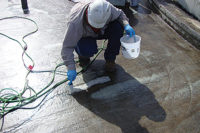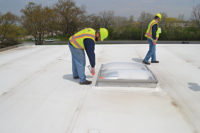
What are the most common problems affecting the life of the membrane?
Ponded water is considered a problem when it doesn’t drain off the roof in a 48-hour period. Water that is allowed to pond on the roof’s surface for an extended time will ultimately adversely affect the membrane, particularly its laps. Deterioration of the membrane often begins when water enters the laps. In cold climates, membrane deterioration can be created from the stresses caused by the forces exerted by ice as it expands and contracts. Sometimes simply unclogging existing drains or inserting a drain in any low, ponded areas can fix the problem.Alternatively, the low areas of the roof can be built up and the flow of water redirected to existing drains, scuppers or roof edges. A side problem from ponded water can be plant or vegetation growth. Roots from vegetation can be very damaging to the membrane when allowed to grow. When left unattended too long, the solution is a total repair or replacement of the affected area(s).
Excessive foot traffic and vandalism also can damage the membrane system. The best way to protect a roof investment is to limit access to the roof or to have a maintenance person accompany anyone going onto to the roof. It always is important to keep a log of who has been on the roof, the purpose and area visited, so that re-occurring damage can be prevented and the guilty party held responsible for any repair. In cases where high traffic cannot be avoided, the owner should select a durable membrane system such as built-up roofing or modified bitumen and also install walk pads leading from the roof access directly to the equipment being serviced.
Another problem is membrane deterioration caused by air conditioning condensate. AC discharge that is allowed to flow over the membrane can be very harmful. In addition, AC rooftop units are often cleaned with coil cleaning detergents, algaecides and fungicides that also can attack the membrane. Most AC discharge is directed off the roof or into a drainage system through the use of a system of pipes. Unfortunately, piping systems usually get clogged after a few years, causing the liquid discharge to pond or flow over some membrane areas.
Another method is to direct the discharge into a pan where it can evaporate. Unfortunately, unless the pans are cleaned periodically, the discharge will overflow. One recent method to overcome this has been the use of rooftop-mounted drainage channels that direct the AC discharge off the roof. These channels are easy to install and maintain, and are often cleaned by rainfall, which dilutes the mixture and washes it harmlessly off of the roof.
What are the most common flashing problems?
After clogged drains, poorly designed and installed flashing details can be a big headache for the owner. Any penetration can be a potential opening for water to enter the building. Proper maintenance procedures can often catch the problem before it develops into a leak. Suspect areas can be found where non-load-bearing walls intersect with the deck, allowing differential movement or racking of the base flashing. This movement often leads to wrinkling and splitting of the base flashing and resulting leaks. Proper design should have dictated the installation of a roof-to-wall expansion joint to provide the proper flexibility to eliminate any problems. The use of pitch pans always has been a problem and should be avoided whenever possible. Pitch pans should be inspected on a regular basis. It is important to use a permanent filler rather than asphaltic roof cement, which shrinks and cracks over time.When should I reroof and when should I replace the roof?
While proper maintenance will extend the service life of the roof, nothing lasts forever and eventually the decision must be made to replace the existing roof. If the roof is worn in only a few areas, then a partial replacement of the affected areas must be considered, especially if the owner’s budget is a factor. Care must be exercised when doing the repairs so as not to cause damage to adjacent areas. Even at that, new sections may redirect the stress to the existing areas, making future inspection and maintenance even more critical.
Another dictate is the activity within the building. For example, it would not make sense to shut down a production line during peak season, but rather to schedule the replacement when product requirements might not be as critical, or when inventory can be built up to meet the anticipated need.
When should I tear off a roof rather than reroof over an existing membrane and insulation?
When reroofing, a decision must be made as to whether the existing insulation can be saved or if a total tear-off down to the deck is required. Wet insulation not only is ineffective, it also will transfer the problems of the old membrane system to the new one. In cases like this, a non-destructive moisture evaluation of the existing roof can be an invaluable tool in deciding whether the roof is wet or not. In any case, the deck must be examined to determine if it is adequate to support the new roofing system for the anticipated number of years.
When recovering an existing membrane, the deck must be sound enough to support the added weight for the anticipated life of the new roofing system. An inspection of the deck’s undersides may reveal whether the deck is adequate for a reroof or in need of repair and/or replacement. The deck type dictates the best way to examine the integrity of the deck. Wood decks can appear to look sound on the surface but can be rotten and deteriorated to the point of collapse when properly examined. A sharp probe is usually sufficient to reveal a rotten area. Lightweight concrete, on the other hand, may reveal very little from a casual under-deck inspection, requiring a check of the surface to show if deterioration had occurred due to freezing. Metal decks must be checked for deflection as well as signs of rust or corrosion. Wood fiber and portland cementitious decks need to be examined for swelling and softness.
When is it feasible to reroof over an existing membrane system?
Once the deck has been examined and deemed adequate to re-use, a survey also must be made of the existing membrane and insulation to make certain that they are free from moisture and can be left in place. Non-destructive moisture detection devices are best for this. And lastly, core samples must be taken to verify the wet areas, determine the exact type of construction, the type and condition of the insulation, and possibly the adequacy of its attachment.Only when the examination shows the deck to be sound and the insulation dry and adequately attached, can plans be made to roof over the existing membrane. The existing insulation should be allowed to vent by slitting the old membrane and a vented base sheet applied over it. This will allow any moisture still in the system to vent and not cause problems with the new roofing system.
Never directly attach a new membrane to an existing one without some type of separation to prevent stresses in the old roof from transmitting to the new roof. Always apply the venting base sheet with the granule/channel side down. This allows the channels or grid to vent any vapor pressure laterally to the roof’s edge detail or to pressure relief valves (vents). It is recommended that one roof vent be installed for every 10 squares of roof surface. Use only one-way pressure-relief vents so that any pressure released during the heat of the day is not drawn back into the roofing assembly during the cooler night.
Always replace nailers and check all curbing to make certain that they provide a good, solid base for fastening the roof and edge details. Cracks in walls and poor mortar joints should be repaired. Replace all bituminous flashings since aged asphalt cracks and looses its effectiveness. If extreme care is taken, it may be possible to re-use edge metal and cap flashing. Always replace any damaged pieces with new metal of the same type and configuration.
Many owners feel that the longevity of their roof starts and ends with its design and application. While these are two very important considerations, they are not all that is required to maximize the life expectancy of a roofing investment. A regularly scheduled maintenance program is key to the longevity of a roofing system. Just as the long-term performance of a car is improved with regular service, a little attention will often extend the life of a roof by several seasons. Just a simple check-up, spring and fall, will catch most problems before they can cause major damage.


Report Abusive Comment